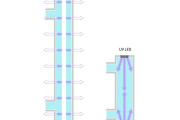Zilog, a wholly-owned subsidiary of IXYS Corporation and a pioneer supplier of microcontrollers (MCUs) providing solutions for the industrial, telecommunication, automotive and consumer markets, today announced the release of Zilog’s new DMX Reference Design Kit which includes a DMX512-A Receiver with our Z51F0811 MCU and a DMX512-A Controller using our Z51F3220 MCU.
The receiver functions mainly as a light controller and, alternately, as a sound generator. As a lighting device, the receiver obtains data from the DMX controller that manages the display of four high-bright LEDs using the Z51F0811 MCU’s PWM function. As a sound generator, the receiver activates a speaker that is connected to the Z51F0811 MCU’s buzzer driver. The UART peripheral of the Z51F0811 MCU is used to connect the DMX512-A receiver to the DMX512-A controller. The source code file associated with this reference design, RD0015-SC01.zip, is available free from the Zilog website. This source code has been compiled using the Keil uVision4 development tool, which is available from Keil.
Using Zilog’s DMX512-A controller with Zilog’s Z51F3220 MCU provides an understanding of the DMX512-A protocol, including its theory of operation. This reference design operates in one of three modes:
-
Local Mode – In this mode, five control potentiometers are used to set transmitted light levels for each related Digital Multiplex (DMX) channel; each potentiometer corresponds to a single DMX channel.
-
PC Mode – In this mode, a PC application is required. This PC application has two main functions:
-
The DMX Controller Function – This function provides two methods of updating and transmitting light levels to a DMX Universe through the DMX512-A controller. In the Auto-Fade method, light levels are set through sliders. All values from the set light levels down to zero (0) and from zero (0) up to the set light levels are transmitted continuously when played. In the Real-Time method, light levels are transmitted each time a slider value changes.
-
The Write to EEPROM function is used to download lighting sequences into the DMX512-A controller’s EEPROM.
-
Demo Mode – In this mode, stored light sequences in the DMX controller’s EEPROM are transmitted to a DMX Universe.
Key Features
This reference design features the following elements:
-
Configurable DMX base slot address via six-position DIP switch
-
Optically-isolated DMX512-A interface
-
Four high-brightness LEDs
-
Buzzer for generating sound output
-
Ability to manipulate NULL start code (0) and alternate start code (207)
-
Three modes of operation: Local, PC, and Demo
-
Local Mode allows control via five on-board potentiometers
-
PC Mode allows control via a PC application
-
Demo mode allows pre-stored sequences to be generated
-
Potential Applications
This reference design can be used to develop a variety of lighting applications; examples include:
-
Dimmer light controls
-
Changing color light controls
-
Moving light controls
-
Light sequence controls
-
Goes Before Optics (GOBO) lighting devices
Zilog’s DMX Reference Design Kit is now available for customers that place orders through the Zilog Store. For more information, visit www.zilog.com.





 CN
TW
EN
CN
TW
EN





